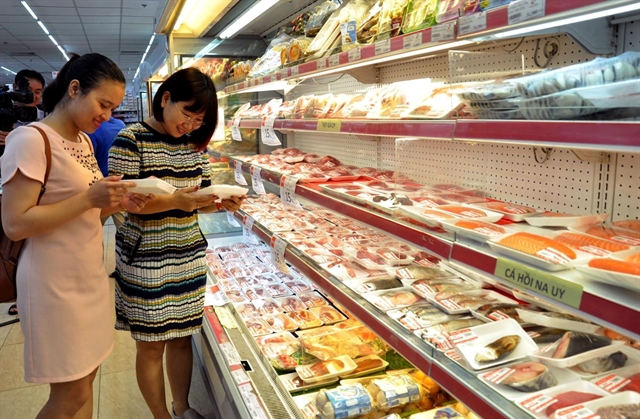 Economy
Economy

.jpg) |
| A farmer tends to his herd at a farm in northern Việt Nam. VNA/VNS Photo |
HÀ NỘI In 2024, Việt Nam per capita pork consumption reached approximately 37kg per person per year, ranking fourth globally, according to a report by the Department of Livestock Production and Animal Health under the Ministry of Agriculture and Environment, presented at a conference yesterday in Hà Nội.
Over the past five years, the country's pork consumption has increased steadily. The total pig herd reached approximately 32 million head by the end of 2024, up seven million from 2020 and nearly two million from 2023. This marked the highest pig population in five years. However, by the end of the first quarter of 2025, the number had declined slightly to 31.8 million, said the report.
Between 2020 and 2024, pigs accounted for 60-64 per cent of total livestock in Việt Nam, exceeding the global average by about 20 per cent. The industry has undergone a major shift, with small-scale household farming decreasing while professional farms and large-scale operations have expanded. Currently, smallholder pig farming contributes only 30 per cent of production, while industrial farms and professional livestock operations account for 70 per cent.
Việt Nam has consistently ranked among the world's top pork-consuming nations. According to the US Department of Agriculture, the country was the sixth-largest pork market from 2021 to 2023. In 2024, domestic pork production reached 5.2 million tonnes, representing 4.3 per cent of global pork supply. Consumption per capita grew rapidly from 30kg in 2021 to 37kg in 2024.
In 2024, live hog prices peaked at VNĐ67,700 per kg. Entering the first quarter of 2025, prices saw atypical fluctuations. The Lunar New Year holiday drove up pork demand, pushing prices to an average of VNĐ76,500 per kg in March, with some periods exceeding VNĐ80,000 per kg. However, this price surge was short-lived. By late March, prices began declining, ranging from VNĐ66,000 to 76,000 per kg, depending on location and whether pigs were sourced from large farms or independent producers. As of March 31, the national average price stood at VNĐ69,000 per kg, nearly VNĐ10,000 per kg higher than the peak price recorded in 2024.
Market fluctuations were driven by multiple factors, including African swine fever outbreaks and regulatory changes. The 2025 Livestock Law, which took effect on January 1, imposed stricter conditions on pig farming, forcing some small and medium-sized farms to shut down or downsize, leading to temporary supply shortages in early 2025.
Despite recent increases, the country's pork consumption may face downward pressure in the coming years. The Department of Livestock Production and Animal Health predicted that from 2025 to 2026, pork demand will be influenced by a shift towards alternative proteins, including poultry, seafood and plant-based options. Rising environmental concerns over pig farming’s ecological footprint may also encourage a move toward more sustainable livestock practices.
Additionally, price sensitivity could impact consumption patterns. Poultry remains a more affordable option, making it an attractive alternative, particularly in times of economic uncertainty. Advances in farming technology will play a crucial role in shaping the future of pig farming, as producers seek to optimise efficiency, improve disease control and manage costs through digital solutions and automation. VNS




